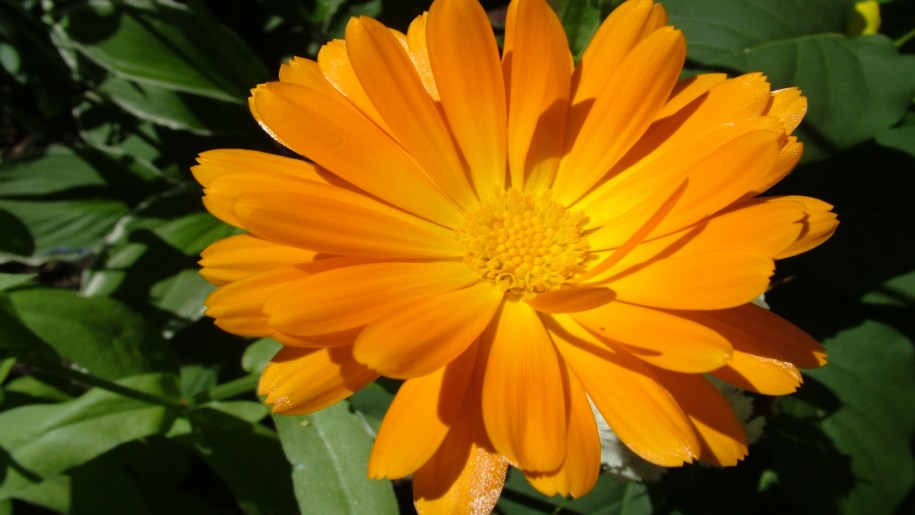
Psoriasis Reduction with Marigold / Calendula
Marigold – or – Calendula officinalis Linnaeus – in China it is called, 金盏菊 jin zhan ju.
I am very comfortable with Calendula. It has been used in traditional medicine for many hundreds of years. I infuse it and drink it as a tea. I also apply the filtered liquid infusion to my skin and hair. It seems to reduce my skin plaques / psoriatic lesions. I seem to have no allergic reaction to Calendula. I vary the strength of the infusions according to my mood
There is abundant good science available about Calendula online – I will quote from 4 websites which I especially like & have bookmarked.
a) Calendula is a genus of about 15–20 species of annual and perennial herbaceous plants in the daisy family Asteraceae that are often known as Marigolds.
b) Plant pharmacological studies have suggested that Calendula extracts have antiviral, antigenotoxic, and anti-inflammatory properties in vitro. In herbalism, Calendula in suspension or in tincture is used topically for treating acne, reducing inflammation, controlling bleeding, and soothing irritated tissue. Limited evidence indicates Calendula cream or ointment is effective in treating radiation dermatitis. Topical application of C. officinalis ointment has helped to prevent dermatitis and pain; thus reducing the incidence rate of skipped radiation treatments in randomized trials.
c) Calendula ointments are skin products used to treat minor cuts, burns, and skin irritation.
d) During the American Civil War, calendula flowers were used on the battlefields in open wounds as antihemorrhagic and antiseptic, and they were used in dressing wounds to promote healing. Calendula also was used in this way during World War I. Calendula has been historically significant in medicine in many cultures, and it is still important in alternative medicine today.
2) University of Maryland Medical Center (UMMC) – they also mention many scientific studies.
The flower petals of the calendula plant (Calendula officinalis), or pot marigold, have been used for medicinal purposes since at least the 12th century. Calendula is native to Mediterranean countries but is now grown as an ornamental plant throughout the world. However, it is not the same as the annual marigold plant that is often grown in gardens.
Calendula has high amounts of flavonoids, plant-based antioxidants that protect cells from being damaged by unstable molecules called free radicals. Calendula appears to fight inflammation, viruses, and bacteria.
Traditionally, calendula has been used to treat stomach upset and ulcers, as well as relieve menstrual cramps, but there is no scientific evidence that calendula works for these problems. Today, calendula is often used topically, meaning it is applied to the skin.
Calendula has been shown to help wounds heal faster, possibly by increasing blood flow and oxygen to the affected area, which helps the body grow new tissue. It is also used to improve skin hydration and firmness. The dried petals of the calendula plant are used in tinctures, ointments, and washes to treat burns, bruises, and cuts, as well as the minor infections they cause. Calendula also has been shown to help prevent dermatitis or skin inflammation in people with breast cancer during radiation therapy.
Use the freshly dried flower heads to make creams, salves, liniments, teas, tinctures, and oils, or add the flower heads directly to your bath to soothe irritated skin. For internal conditions, take one to three dropperfuls of tincture in a little water several times daily (though be sure to check with your healthcare professional first).
~ Calendula officinalis extract can aid in wound healing by promoting epithelial growth and by enhancing immune responses (Duran, V., Matic, M., Jovanovc, M., Mimica, N., Gajinov, Z., Poljacki, M., and Boza, P. Results of the clinical examination of an ointment with marigold (Calendula officinalis) extract in the treatment of venous leg ulcers. Int J Tissue React 2005;27(3):101-106)
~ Calendula gel applied for two weeks to patients with burns or scalds provided very good results – the Calendula was compared against a proteolytic gel and had a similar level of efficacy but was better tolerated (Baranov AP: Dtsch Apoth Ztg 139;61-66, 1999)
~ In Germany the Commission E supports Calendula to treat oral and pharyngeal mucosa internally and topically. Externally, Calendula is recommended for poorly healing wounds and leg ulcers (Blumenthal M et al, editors: Commission E monographs, Austin, 1998)
This entry was posted in Nature on 01 Mar, 2017 by Pandora
| Seaweed
4 Comments to "Marigold / Calendula"
test
Hello! Cool post, amazing!!!
Very good article. I definitely appreciate this website.
Continue the good work!
Hi, this is a comment.
To get started with moderating, editing, and deleting comments, please visit the Comments screen in the dashboard.
Commenter avatars come from Gravatar.